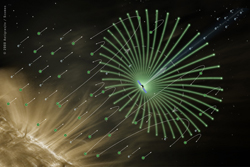Faster and ‘greener’ spacecraft
Powering spacecraft has traditionally relied on chemical propellants and ion engines. For long missions their needed propellant increases the launch mass which makes the mission expensive. Harnessing the power of the solar wind, a constant stream of charged particles ejected by the Sun, could provide renewable thrust for spacecraft propulsion. The electric solar wind sail would enable inexhaustible flight in the solar system and reduce the time, cost and mass required for spacecraft to reach their targets. In 2006, Pekka Janhunen introduced the concept of an electric solar wind sail that provided tremendous improvements over the existing space propulsion methods. An E-sail uses wire tethers unreeled in space like fishing lines. They are kept taut by centrifugal force and charged by an onboard electron gun powered by solar panels. They use the solar wind's charged ions as a natural source to produce thrust. EU funding of the 'Electric sail propulsion technology' (ESAIL) project is enabling Janhunen and his team to develop the key technologies to prototype level. To date, scientists have already produced 300 metres of final type four-wire tether. The goal of the ESAIL project is to produce a one kilometer sample tether by an automatic, scalable method. They are also well on their way to building a prototype of the 'Remote Unit' at the tips of each main tether and their thrusters. The researchers have also demonstrated successful reel-in and reel-out of a 30 metre long tether without any problems. The ESAIL project is expected to deliver prototypes of the key components of the E-sail, opening the door to a new generation of efficient solar system flight and unimaginable opportunities for exploration of our Solar System.



